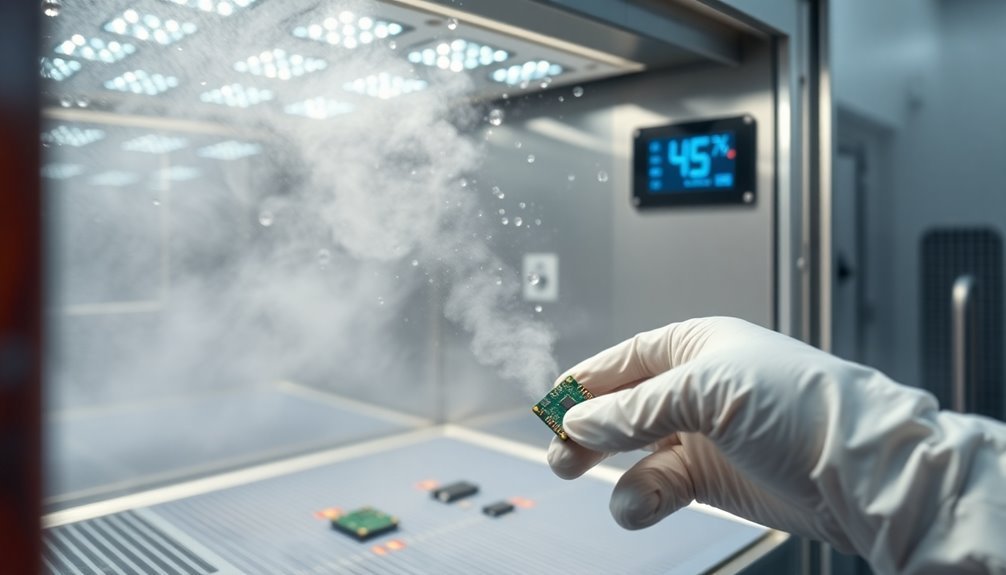You can prevent static damage in your facility through three essential humidity control methods. First, maintain ideal moisture levels between 45-55% relative humidity, which allows the air to naturally dissipate electrical charges. Second, implement direct room humidification systems that provide precise control and 100% water utilization, especially effective in data centers and electronics manufacturing. Third, use localized climate control solutions around heat-generating equipment to address dry spots that lead to static buildup. Understanding these methods and their proper implementation will help you create a thorough static prevention strategy.
Maintaining Optimal Moisture Levels

Industry's battle against static electricity often comes down to one key factor: humidity control. You'll find that maintaining the best moisture levels in the air is essential for preventing static-related damage in manufacturing environments.
When you keep relative humidity at 55%, you'll effectively stop static from building up, as moisture in the air acts as a natural conductor that dissipates electrical charges.
You need to pay attention to humidity thresholds, as static electricity becomes problematic when levels drop below 45% RH. Between 45-55% RH, you'll notice that static decreases as humidity rises. However, you can't rely solely on humidity control – it reduces but doesn't eliminate ESD events completely.
Temperature plays an important role in your humidity management strategy. You'll discover that seasonal changes substantially impact your static control efforts, especially during autumn and winter when humidity naturally drops. In arid climates, you'll face year-round challenges. Heat from industrial machines creates dry micro-climates that can intensify static build-up problems.
That's why understanding the relationship between temperature and absolute humidity becomes critical – it's not just about relative humidity, but the actual amount of moisture present in the air that determines your success in preventing static electricity problems.
Direct Room Humidification Systems
Three main types of direct room humidification systems dominate the market today, each offering unique solutions for maintaining ideal moisture levels. You'll find these systems particularly effective in data centers, electronics manufacturing facilities, and industrial environments where static electricity poses a significant risk.
When you're considering a direct room humidification system like the STULZ DRH, you'll benefit from precise humidity control and 100% water utilization. These systems can maintain humidity levels above 55% RH, effectively eliminating static buildup while requiring minimal maintenance and reducing operational costs. The system's versatility makes it ideal for libraries and museums requiring stable atmospheric conditions.
- Produces droplets 90% smaller than traditional nozzle systems, ensuring efficient humidification
- Features capacity ranges from 4.4-17.6 lbs/hr, suitable for various facility sizes
- Includes integral blowers and washable filters for superior performance
- Offers flexible mounting options for walls, columns, or below-ceiling installation
- Meets California's Title 24 requirements while improving overall air quality
These systems stand out due to their remarkable energy efficiency, using only 7% of the power required by traditional electric steam humidifiers.
Localized Climate Control Solutions

Building on the efficiency of direct room systems, localized climate control solutions offer even more precise humidity management for specific areas and equipment. You'll find these systems particularly effective in maintaining the critical 45-55% RH range needed to prevent static electricity buildup, especially around industrial machinery where heat can create problematic dry spots. Building moisture levels must be carefully monitored to avoid structural and health risks.
You can customize your HVAC systems to address specific microclimates using technologies like heat pipes, moisture-absorbing pads, and heat recovery wheels. These solutions don't just control humidity – they'll help you save energy too. Heat recovery wheels transfer both heat and moisture between air streams, while moisture-absorbing pads can cut humidity by up to 35% and regenerate using sunlight.
When you implement localized climate control, you'll see improvements in both system performance and energy efficiency. By optimizing your dehumidification strategies, you can enhance your HVAC system's latent capacity by 16-71%.
You'll also prevent excessive energy consumption by targeting specific areas rather than treating entire spaces. Remember to adjust airflow rates during cooling cycles and prioritize ventilation timing to maximize efficiency while maintaining ideal humidity levels for static prevention.
Frequently Asked Questions
How Quickly Can Static Buildup Occur in Environments Below 45% RH?
You'll notice static buildup can occur instantly in environments below 45% RH, as the lack of moisture prevents natural charge dissipation, making surfaces immediately susceptible to accumulating static electricity.
Can Excessive Humidity Levels Damage Electronic Components or Manufacturing Equipment?
Yes, you'll find that excessive humidity can severely damage your electronics through corrosion, short circuits, and weakened insulation. It'll also harm manufacturing equipment by causing condensation, mold growth, and compromised electrical components.
What Industries Experience the Highest Financial Losses From Static-Related Damage?
You'll find the electronics and manufacturing industries face the highest financial losses, with component manufacturers seeing up to 97% losses and users experiencing up to 70% losses due to static-related damage.
How Do Seasonal Temperature Fluctuations Affect Static Control Measures?
You'll notice static control becomes harder in winter when cold temperatures lower humidity levels. During summer, air conditioning removes moisture, but winter's naturally drier air creates the biggest challenge for maintaining effective static control.
Are There Specific Humidity Requirements for Different Types of Electronic Materials?
Yes, you'll find different electronics need varying humidity levels: most require 30-70% RH, ESD-sensitive components work best at 40-60% RH, while moisture-sensitive parts may need lower levels to prevent damage.
In Summary
You'll find that proper humidity control is essential for protecting your sensitive equipment from static damage. Whether you're using whole-room humidification, targeted moisture control, or localized climate solutions, maintaining ideal moisture levels between 40-60% relative humidity will safeguard your electronics and materials. Don't overlook this vital aspect of equipment protection – implement these humidity control methods to prevent costly static-related failures.





Leave a Reply